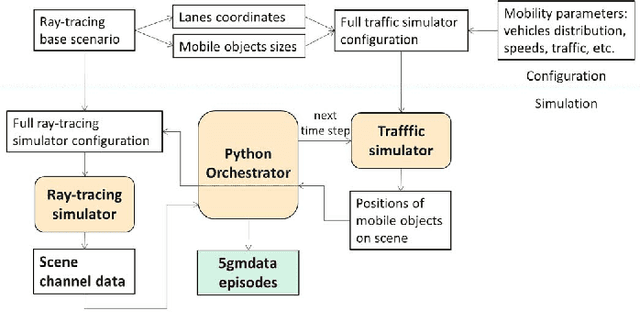Pedro Batista
CAVIAR: Co-simulation of 6G Communications, 3D Scenarios and AI for Digital Twins
Jan 06, 2024Abstract:Digital twins are an important technology for advancing mobile communications, specially in use cases that require simultaneously simulating the wireless channel, 3D scenes and machine learning. Aiming at providing a solution to this demand, this work describes a modular co-simulation methodology called CAVIAR. Here, CAVIAR is upgraded to support a message passing library and enable the virtual counterpart of a digital twin system using different 6G-related simulators. The main contributions of this work are the detailed description of different CAVIAR architectures, the implementation of this methodology to assess a 6G use case of UAV-based search and rescue mission (SAR), and the generation of benchmarking data about the computational resource usage. For executing the SAR co-simulation we adopt five open-source solutions: the physical and link level network simulator Sionna, the simulator for autonomous vehicles AirSim, scikit-learn for training a decision tree for MIMO beam selection, Yolov8 for the detection of rescue targets and NATS for message passing. Results for the implemented SAR use case suggest that the methodology can run in a single machine, with the main demanded resources being the CPU processing and the GPU memory.
5G MIMO Data for Machine Learning: Application to Beam-Selection using Deep Learning
Jun 09, 2021



Abstract:The increasing complexity of configuring cellular networks suggests that machine learning (ML) can effectively improve 5G technologies. Deep learning has proven successful in ML tasks such as speech processing and computational vision, with a performance that scales with the amount of available data. The lack of large datasets inhibits the flourish of deep learning applications in wireless communications. This paper presents a methodology that combines a vehicle traffic simulator with a raytracing simulator, to generate channel realizations representing 5G scenarios with mobility of both transceivers and objects. The paper then describes a specific dataset for investigating beams-election techniques on vehicle-to-infrastructure using millimeter waves. Experiments using deep learning in classification, regression and reinforcement learning problems illustrate the use of datasets generated with the proposed methodology
 Add to Chrome
Add to Chrome Add to Firefox
Add to Firefox Add to Edge
Add to Edge